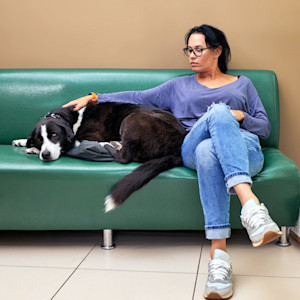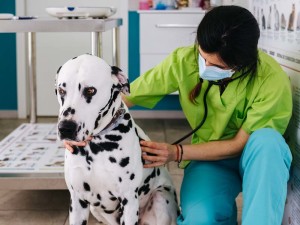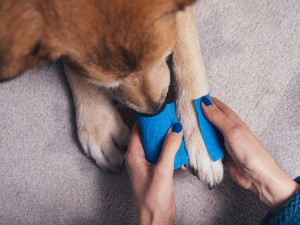How to Treat a Bladder Infection in Dogs
What you can do to help them.

Share Article
In This Article:
Common Predisposing Conditions for Bladder Infections in Dogs How to Diagnose a Bladder Infection What Treatments to Expect From Your Vet How to Treat a Dog’s Bladder Infection at Home
Bladder infections in dogs are not subtle affairs. Your stoic pup who can normally hold their pee all day is suddenly distressed, whimpering, and begging to go out constantly. They may be obsessively licking at their genital area, having accidents inside, or even urinating with blood. All of these signs mean it's time to see a vet, pronto. The good news is that most dogs feel better quickly with the proper treatment.
Veterinarians typically treat dog bladder infections through a comprehensive approach. This includes conducting a urinalysis to identify the specific bacteria, prescribing targeted antibiotics, and providing additional supportive care as needed. Vets may also recommend dietary changes, and conduct additional tests to rule out underlying health conditions. Follow-up visits are crucial to ensure the infection is fully resolved and to prevent potential recurrence.
Common predisposing conditions to bladder infections in dogs
Bladder infections are the result of bacteria, or occasionally viruses or fungi, that are able to take hold within the bladder and urinary tract. In healthy animals, there are many natural defenses in the body that prevent this from happening. When these defenses break down, this can lead to infections. Some conditions that weaken the body’s natural defenses to bladder infections include:

Common bladder predisposing conditions
Bladder stones: Stones are clumps of sediment made from a combination of mineral deposits within the bladder. They can form for many different reasons. Once they form, they irritate the lining of the bladder, creating inflammation and damage that can allow bacteria to easily take hold.
Kidney disease: Kidney disease in dogs can be caused by many different conditions, and when it is more advanced, it results in dilute urine. As the urine becomes more dilute, it is a more welcoming environment for bacteria to grow.
Bladder tumors or bladder cancer: Cancer in the bladder causes tissue damage and inflammation, which can break down the lining of the bladder and allow bacteria to flourish.
Prostate issues: Prostate issues are a risk in intact male dogs. They can develop an enlarged prostate, infections of the prostate, or prostate cancer. All of these conditions can interfere with normal urination and the bladder’s natural defenses, leading to infections.
Hormone imbalance: Diseases that affect hormones, including diabetes and Cushing’s disease, also lead to more diluted urine and suppress normal immune function. This creates a perfect storm for infections to take hold.
Mobility issues: Dogs that have severe mobility issues, hindlimb paralysis, or other neurologic problems may have trouble emptying their bladder completely, or may be incontinent and leak urine. These conditions can result in urine sitting too long in the urinary tract, giving bacteria time to set up shop.
Incontinence: Dogs who have urinary or fecal incontinence will have challenges maintaining good hygiene around their genitals. If they are sitting in soiled bedding or have soiled fur, pathogens in their waste can more easily make their way into the urinary tract.
Congenital conditions: Some dogs may be born with variations in their anatomy that interfere with normal urination, leading to more infections. This includes conditions like ectopic ureters or hooded vulvas.
How to diagnose a canine bladder infection
Tests performed by a veterinarian are the only way to diagnose a bladder infection. While many times a dog’s symptoms seem like an obvious bladder infection, there can be other conditions that cause similar symptoms and require a very different treatment approach. Bladder infections require targeted treatment with specific antibiotics. However, if a dog does not have a true infection, unnecessary exposure to antibiotics can cause unwanted side effects and contribute to antibiotic resistanceopens in new tab.
When to consult a vet
Any time a dog has sudden changes in their urinary habits, it is important to see a vet. This is especially urgent when the signs include:
Pain: Signs of pain vary between dogs but common ones include whimpering, licking their genitals, and/or hiding.
Bleeding: Blood in the urine or blood dripping from the genitals is always an emergency.
Lethargy: If your dog is not willing to get up, play, go on walks, or even interact with you, this is a sign they are really feeling sick and need to see a vet.
Fever: It can be difficult to know if your dog has a fever because they tend to be warmer than humans all the time. Signs of fever can include lethargy and loss of appetite, too.
Foul-smelling urine: If you notice a sudden change in the smell of your dog’s pee, this can be a sign of an infection or other medical condition.
Accidents indoors: When a dog who is very reliably house-trained suddenly starts having accidents inside, it is a red flag that something is wrong.
How your veterinarian will diagnose a bladder infection
Your vet will use a number of different tools to diagnose a urinary tract infection and look for underlying conditions.
Physical exam: A thorough physical exam can reveal a lot including abnormal anatomy that may be a predisposing factor.
Urinalysis: A urinalysis is a microscopic study of your dog’s urine sample. It looks for signs of infection, including bacteria, white blood cells, and blood. It also provides information on how concentrated the urine is and whether there are other abnormal changes to the urine including the pH or presence of crystals.
Culture and sensitivity: This is the best way to target antibiotic therapy to an infection. It involves taking a sample of the bacteria from the urine and growing it in a culture and then testing specific antibiotics against that bacteria. This helps to ensure that the correct antibiotic is selected to destroy the specific bacteria in your dog’s infection.
Blood work: Your vet may also recommend blood work to look for other predisposing conditions that lead to bladder infections. This includes evaluating the kidneys and looking for signs of diabetes, Cushing’s disease and other systemic disease.
X-Rays or ultrasound: These forms of imaging are very useful in looking for bladder stones. Ultrasound can also be helpful in evaluating the bladder for signs of thickening or other abnormalities.
What treatments to expect from your vet
Your vet will use the results of diagnostic tests and the history you provide to craft a plan for your dog’s bladder infection treatment. This may include:
Antibiotics
Antibiotics are necessary to help destroy the bacteria and clear the infection. They should only be taken when prescribed by a vet as a bacterial infection is not always the cause of a dog’s urinary symptoms.
Fluids
Depending on your vet’s exam findings, they may recommend fluids either through an IV or under the skin (subcutaneously) to help hydrate your dog and dilute their urine. This can help them feel better if they have a fever or have not been eating. Diluting their urine will help them urinate more comfortably until the infection clears up.
Pain medication
Dogs that are showing signs of pain will benefit from safe pain medications to provide fast relief. Your vet will prescribe the most appropriate medication given your dog’s needs and health conditions.
Additional supportive care
If your dog has a specific underlying condition that led to their bladder infection, they may require additional treatments as well. This could include follow-up tests, surgery to address conditions like bladder stones, special diets, or additional medications.
How to treat a dog’s bladder infection at home
It is important to note that you cannot effectively treat a dog’s bladder infection at home. Bladder infections require prescription medications targeted for your dog’s specific type of infection and underlying conditions. Without prompt and appropriate care, bladder infections can lead to serious complications, including extreme pain, life-threatening kidney infections known as pyelonephritis, or systemic infections known as sepsis. See your vet at the first sign of a bladder infection. Once you have a diagnosis and treatment from your vet, you can support your dog’s recovery with these steps:
Hydrate
Encourage your pup to drink water and stay hydrated while they are recovering. You can tempt them to drink more by offering a little diluted low-sodium broth, or mixing some additional water into their food.
Wet food or special diet
Feeding a canned-food diet will add additional water to their diet and help them stay hydrated. In some cases, your vet may prescribe a special diet to help with underlying conditions like bladder stones, diabetes, or kidney disease.
Frequent bathroom breaks
Take your dog out more frequently to allow them to pee, including anytime they seem restless or whine to go out. This will reduce their distress about having accidents indoors and help you avoid messy cleanups.
Cranberry supplements (without xylitol)
This one is debatable as there is no clear evidence it actually helps dogs with bladder infections. There are also a lot of unreliable supplements out there that don’t contain the active ingredients that they claim to. It may be worth a try for dogs with recurrent infections but be sure to consult your vet first and make sure the supplement is safe and non-toxic.
Hygiene
Be vigilant about keeping your dog’s genital area and hind-end clean. If they are having accidents, you may need to bathe them frequently or trim long fur around their hind end if it becomes soiled.
Follow ups with your vet
Be sure to follow up with your vet if they recommended further testing or treatments for your dog. Also, schedule an appointment right away if your dog is not improved after finishing treatment.
Bottom line
Bladder infections require prompt veterinary care in order get a proper diagnosis and targeted treatment.
There are many medical conditions that predispose dogs to bladder infections, and it is important to check for these, especially in dogs with recurring infections.
Bladder infections cannot be cured with home treatments, but you can provide important support to your dog at home while they are undergoing medical treatment.
References
Brown, Scott. “Bacterial Cystitis in Small Animalsopens in new tab.” Merck Veterinary Manual, September 2015.
Bubenik, Loretta. “Urinary Tract Infection in Dogs with Thoracolumbar Intervertebral Disc Herniation and Urinary Bladder Dysfunction Managed by Manual Expression, Indwelling Catheterization or Intermittent Catheterizationopens in new tab.” Veterinary Surgery, vol. 37, no. 8, December 2008, pp. 791-800.
Lulich, JP, et al. “ACVIM Small Animal Consensus Recommendations on the Treatment and Prevention of Uroliths in Dogs and Catsopens in new tab.” Journal of Veterinary Internal Medicine, vol. 30, no. 5, 9 September 2016, pp. 1564-1574.
Weese, J. Scott, et al. “International Society for Companion Animal Infectious Diseases (ISCAID) guidelines for the diagnosis and management of bacterial urinary tract infections in dogs and catsopens in new tab.” The Veterinary Journal, vol. 247, February 2019, pp. 8-25.

Dr. Amy Fox, DVM
Amy Fox, DVM is a small animal veterinarian in New York City with over thirteen years of experience in a mixture of general practice, emergency medicine, and shelter medicine. A lifelong animal lover, Dr. Fox studied biology in college and then worked as a veterinary nurse before pursuing veterinary school at Cornell University. Her expertise includes surgery, dentistry, and management of chronic conditions, and she is interested in toxicology, pain management, nutrition, care of senior pets, and educational outreach. Dr. Fox also enjoys writing about veterinary medicine and teaching, and her work has previously appeared in Spruce Pets. In her free time, she loves to cook, garden, go for long runs, and hang out with her goofy mixed-breed dog May, who provides never ending comic relief!
Related articles
![Young woman comforting German Shepherd puppy outside.]()
My Dog Is Pooping Blood: What Should I Do?
It’s an alarming sight, but here’s what you should know.
![A mini golden doodle puppy licking and grooming itself.]()
Treatment for Your Dog’s Bleeding Anus: Home Remedies and Medical Options
It’s not a pretty problem, but here are your solutions.
![Woman comforting large black and white dog on the couch.]()
My Dog Has Bloody Diarrhea: What to Do and Home Remedies
And when to visit your veterinarian.
![Dalmatian and Great Dane mixed dog at the vet being checked on by a nurse in bright green scrubs]()
Why Is Your Dog’s Stomach Hard? What to Give a Bloated Dog
And when to be concerned.
How Long Can Puppies Hold Their Pee?
You shouldn’t make them cross their legs for long!
![bandaging dog's bleeding paw]()
How to Care for Your Bleeding Dog
Don’t freak out—here’s what to do.








